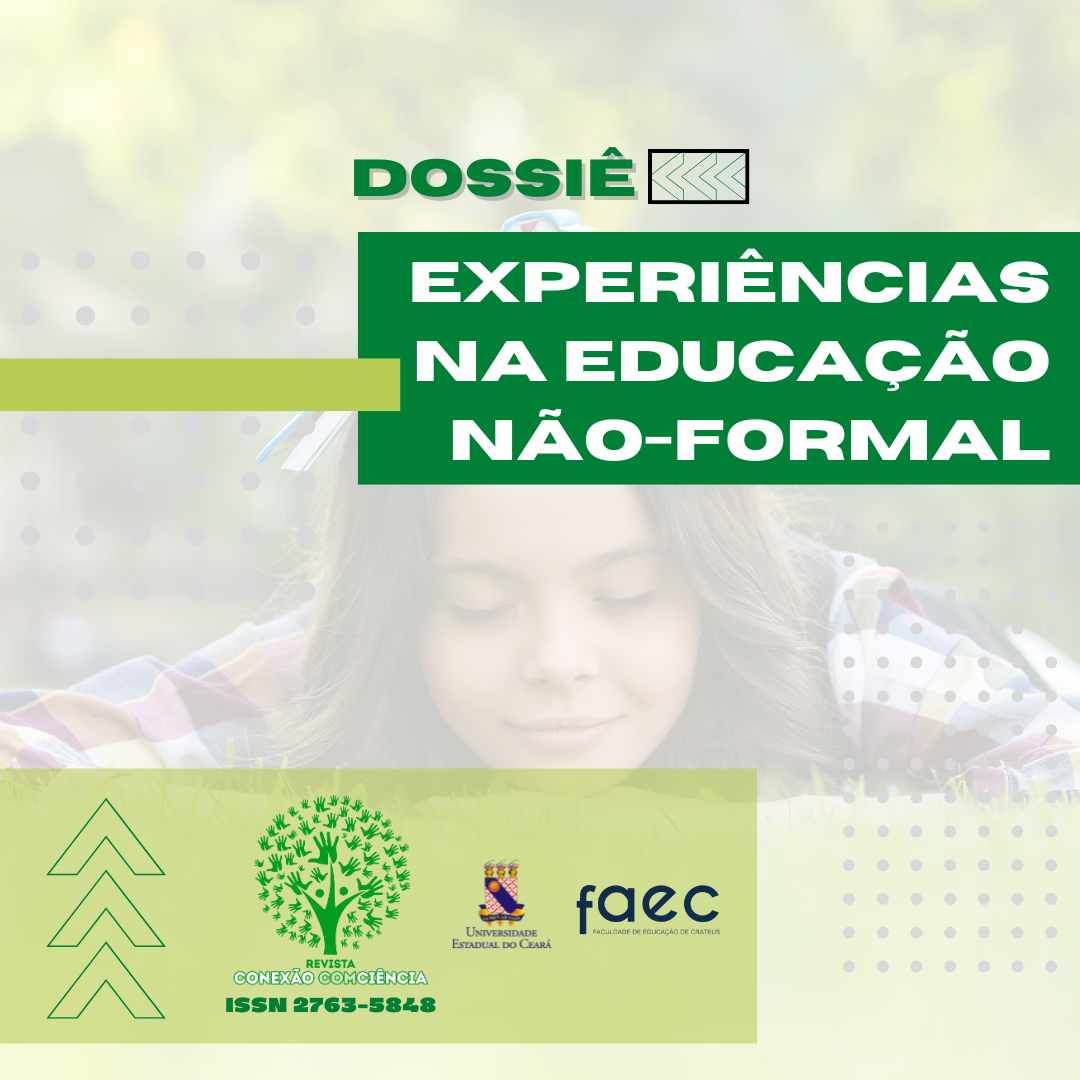Aprendizagem e Candomblé uma análise autoetnográfica sobre corpos e coisas no aprendizado
Conteúdo do artigo principal
Resumo
Os espaços religiosos constituem-se enquanto relevantes nas construções de dinâmicas sociais entre grupos culturais, sendo assim espaço importante na conformação de saberes, de condutas, corpos e paisagens. Nestes processos, são envolvidos diferentes corpos, matérias, materiais e existências que juntos conformam a paisagem do terreiro, a criam cotidianamente através dos tempos. Este artigo tem por objetivo refletir, no contexto de um terreiro de Candomblé sobre as relações que existem entre corpos, seres e coisas no processo de aprendizagem dos filhos e filhas de Òrìṣà, a partir da autoetnografia como princípio metodológico. O aprendizado no terreiro de Candomblé leva o devoto à uma educação do corpo, das características físicas e sutis das matérias, ao entendimento da vida coletiva e compartilhada. Cada um destes elementos envolvidos nas práticas cotidianas e rituais possuem papel ativo na educação dos filhos e filhas de Òrìṣà, sendo seus corpos substâncias de criação e manutenção do Àse.
Detalhes do artigo

Este trabalho está licenciado sob uma licença Creative Commons Attribution 4.0 International License.
Referências
BENJAMIN, Walter. O narrador: considerações sobre a obra de Nikolai Leskov. In: Obras escolhidas. Magia e técnica, arte e política. 7. ed. São Paulo: Brasiliense, 1996. Disponível em: https://www.usp.br/cje/depaula/wp-content/uploads/2017/03/O-Narrador_Walter-Benjamin-1.pdf
BONDÍA, Jorge Larrosa. Notas sobre a experiência e o saber de experiência. Revista Brasileira de Educação, nº 19: 20-28, Jan/Fev/Mar/Abr, 2002.
CARDOSO, Ângelo Nonato Natale. A Linguagem dos Tambores. Tese de Doutorado. Programa de Pós Graduação em Música e Etnomusicologia. Escola de Música UFBA, Salvador, 2006. Disponível em: https://repositorio.ufba.br/bitstream/ri/9112/1/Tese%20Angelo%20Cardoso%20parte%201.pdf
CAPUTO, Stela Guedes. Educação nos terreiros: e como a escola se relaciona com as crianças de Candomblé. Pallas. Rio de Janeiro. 2012.Disponível em: https://periodicos.uff.br/antropolitica/article/view/41585
CHEVALIER, J., & GHEERBRANT, A.). Dicionário de símbolos. Rio de Janeiro: José Olympio. 1989
ELIADE, Mircea. O Sagrado e o profano. Essência das religiões. 5° tiragem, Tradução: Rogério Fernandes. São Paulo, Martins Fontes, 2001. Disponível em: https://gepai.yolasite.com/resources/O%20Sagrado%20E%20O%20Profano%20-%20Mircea%20Eliade.pdf
ELLIS, C., & BOCHNER, A. P. . Autoethnography, Personal Narrative, Reflexivity: Researcher as Subject. In Denzin, N. K., & Lincoln, Y. S. (Eds.), Handbook of Qualitative Research (2nd ed., pp. 733-768). Thousand Oaks, CA: Sage Publications. 2000. Disponível em: https://www.researchgate.net/publication/254703924_Autoethnography_Personal_Narrative_Reflexivity_Researcher_as_Subject
GYEKYE, Kwame, African Ethics. The Stanford Encyclopedia of Philosophy (Fall 2011 Edition), Edward N. Zalta (ed.). 2011. Disponível em: https://plato.stanford.edu/entries/african-ethics/
INGOLD, T. The Perception of the Environment: Essays on Livelihood, Dwelling and Skill. Routledge. London. 2000
INGOLD, T. Being Alive: Essays on Movement, Knowledge and Description. Routledge. 2011
INGOLD, T. Making: Anthropology, Archaeology, Art and Architecture. Routledge. 2013.
LE BRETON, D. Adeus ao corpo: antropologia e sociedade. Campinas: Papirus, 2003.
LE BRETON, D. A sociologia do corpo. 4.ed. Rio de Janeiro: Vozes, 2010.
LIMA, Vivaldo da Costa. A família de santo nos Candomblés jejes-nagôs da Bahia: um estudo de relações intragrupais. Salvador: Corrupio, 2003
.
LIMA, J. M. Corpo e ritual no Candomblé: uma etnografia das práticas religiosas. São Paulo: Editora Selo Negro, 2010.
MAUSS, Marcel. As técnicas do corpo. Sociologia e Antropologia. São Paulo: Cosac & Naify, 2003. p. 401-424
MERLEAU-PONTY, M. Fenomenologia da percepção. São Paulo: Martins Fontes, 1945.
MBEMBE, A. As Formas Africans de Auto-Inscrição. Estudos Afro-Asiáticos, Ano 23, nº 1, 2001, pp. 171-209 Estudos Afro-Asiáticos, Ano 23, nº 1, 2001, pp. 171-209
MBITI, J. S. African Religions and Philosophy. Nairobi: Heinemann. 1990
PARÉS, Luis Nicolau. A formação do Candomblé: história e ritual da nação jeje na Bahia. 2ª ed. Ver. – Campinas, SP: Editora da Unicamp, 2007.
PARÉS, Luís Nicolau. A formação do Candomblé. História e ritual da nação jeje na Bahia. 2ª Ed. rev. Campinas, SP: Editora da Unicamp, 2013.
RAMOSE, Mogobe B. The ethics of ubuntu. In: COETZEE, Peter H.; ROUX, Abraham P.J. (eds). The African Philosophy Reader. New York: Routledge, 2002, p. 324-330
SANTOS, Juana Elbein dos. Os Nàgô e a morte e o culto égun na Bahia. Traduzido pela Universidade Federal da Bahia. Petrópolis, Vozes,1986.
SANTOS, R. A. A dança como linguagem no Candomblé: significados e aprendizagens. Salvador: EdUFBA, 2002
SANTOS, Juana Elbein dos. Os nagô e a morte. Petrópolis: Vozes. 14 Ed., 2012
SCHWARZ, Fernando. A Tradição: e as vias do conhecimento ontem e de hoje. Edição O.I.N.A.B. 1993.
TURNER, V. W. The anthropology of performance. New York: PAJ Publications, 1987.
VARELA, F., THOMPSON, E. & ROSH. E. (1993). Linscription corporelle de lesprit. Sciences cognitives et expérience humaine. Paris: Editions du Seuil.

